Yonghe Temple
The Yonghe Temple (Chinese: 雍和宫, "Palace of Peace and Harmony"), also known as the Yonghe Lamasery, or popularly as the Lama Temple, is a temple and monastery of the Gelug school of Tibetan Buddhism located in Dongcheng District, Beijing, China. The building and artwork of the temple is a combination of Han Chinese and Tibetan styles.
| Yonghe Temple | |||||||||||
|---|---|---|---|---|---|---|---|---|---|---|---|
.jpg) | |||||||||||
| Chinese name | |||||||||||
| Chinese | 雍和宫 | ||||||||||
| |||||||||||
| Tibetan name | |||||||||||
| Tibetan | དགའ་ལྡན་བྱིན་ཆགས་གླིང་ | ||||||||||
| |||||||||||
| Mongolian name | |||||||||||
| Mongolian Cyrillic | Найралт Найрамдyy Сүм | ||||||||||
| |||||||||||
| Manchu name | |||||||||||
| Manchu script | ᡥᡡᠸᠠᠯᡳᠶᠠᠰᡠᠨ ᡥᡡᠸᠠᠯᡳᠶᠠᡴᠠ ᡤᡠᠩ | ||||||||||
| Romanization | hūwaliyasun hūwaliyaka gung | ||||||||||
History
Building work on the Yonghe Temple started in 1694 during the Qing dynasty on the site where originally stood an official residence for court eunuchs of the previous dynasty. It was then converted into the residence of Yinzhen (Prince Yong), the fourth son of the Kangxi Emperor. After Prince Yong ascended the throne as the Yongzheng Emperor in 1722, half of the building was converted into a lamasery, a monastery for monks of Tibetan Buddhism. The other half remained an imperial palace.
After the Yongzheng Emperor's death in 1735, his coffin was placed in the temple. The Qianlong Emperor, who succeeded the Yongzheng Emperor, gave the temple imperial status signified by having its turquoise tiles replaced with yellow tiles which were reserved for the emperor. Subsequently, the monastery became a residence for large numbers of Tibetan Buddhist monks from Mongolia and Tibet, and so the Yonghe Lamasery became the national centre of Lama administration.
The temple was the site of an armed revolt against the Chinese Nationalist government in 1929.[1]
After the Chinese Civil War ended in 1949, the temple was declared a national monument and closed for the following 32 years.[2] It is said to have survived the Cultural Revolution due to the intervention of Premier Zhou Enlai. Reopened to the public in 1981, it is today both a functioning temple and highly popular tourist attraction in the city.
Architecture and artworks
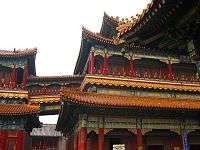
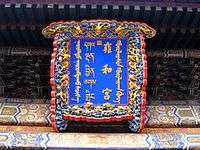
The Yonghe Temple is arranged along a north–south central axis, which has a length of 480 metres. The main gate is at the southern end of this axis. Along the axis, there are five main halls which are separated by courtyards: the Gate Hall of Harmony and Peace (Yonghemendian), the Hall of Harmony and Peace (Yonghegong), the Hall of Everlasting Protection (Yongyoudian), the Hall of the Wheel of the Law (Falundian), and the Pavilion of Ten Thousand Happinesses (Wanfuge).
The Gate Hall of Harmony and Peace is the southernmost of the main halls, it served originally as the main entrance to the monastery. In the center of the hall stands a statue of the Maitreya Buddha, along the walls statues of the four Heavenly Kings are arranged.
The Hall of Harmony and Peace is the main building of the temple. It houses three bronze statues of the Buddhas of the Three Ages, the statue of the Gautama Buddha (Buddha of the Present) is in the center, it is flanked by the statue of Dīpankara Buddha (Buddha of the Past, right) and the Maitreya Buddha (Buddha of the Future, left). Along the sides of the hall, the statues of the 18 Arhats are placed. A mural in the hall shows the bodhisattva Avalokitesvara.
The Hall of Everlasting Protection was Emperor Yongzheng's living quarters as a prince and the place where his coffin was placed after his death. Today, a statue of the Bhaisajya-guru (healing Buddha) stands in this hall.
The Hall of the Wheel of the Law functions as a place for reading scriptures and conducting religious ceremonies. It contains a large statue of Je Tsongkhapa, founder of the Geluk School. The hall also contains the Five-Hundred-Arhat-Hill, a carving made of red sandalwood with statues of the arhats made from five different metals (gold, silver, copper, iron, and tin).
The Pavilion of Ten Thousand Happinesses (sometimes referred to as "The Hall of Boundless Happiness") contains an 18m tall (with an additional 8m underground, making it 26m in total) statue of the Maitreya Buddha carved from a single piece of White Sandalwood. This was a gift from the seventh Dalai Lama to the Qianlong Emperor and took three years to transport from Tibet to Beijing.[3] The statue is one of three artworks in the Temple which were included in the Guinness Book of Records in 1993.
Three fabulous artworks
- three bronze statues of the Buddhas of the Three Ages
- Five-Hundred-Arhat-Hill
- 18m tall White Sandalwood statue of the Maitreya Buddha[4]
Location
The Yonghe Temple is located in Beijing's Dongcheng District, near the northeastern corner of the Second Ring Road. Lines 2 and 5 of the Beijing Subway both stop at Yonghegong Lama Temple Station, as do a number of city buses. The postal address is: 12 Yonghegong Dajie, Beixinqiao, Dongcheng District, Beijing.
Gallery
.jpg) A Chinese guardian lion outside the temple
A Chinese guardian lion outside the temple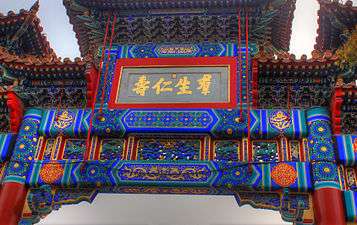 A pailou with 群生仁壽 inscribed on it, at the entrance to the temple
A pailou with 群生仁壽 inscribed on it, at the entrance to the temple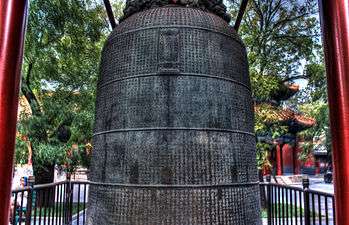 A giant ancient bell
A giant ancient bell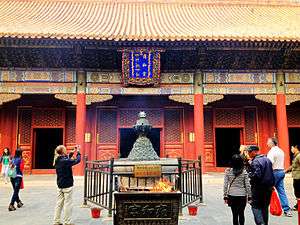 The Hall of Harmony and Peace (雍和宮)
The Hall of Harmony and Peace (雍和宮)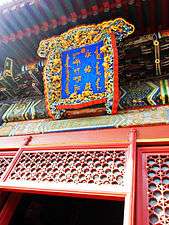 The Hall of Everlasting Protection (永佑殿)
The Hall of Everlasting Protection (永佑殿)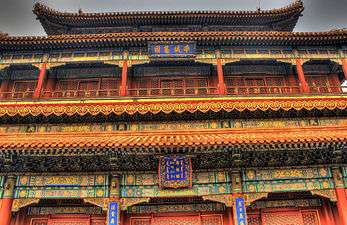 The Pavilion of Ten Thousand Happinesses (萬福閣)
The Pavilion of Ten Thousand Happinesses (萬福閣) The Pavilion of Ten Thousand Happinesses
The Pavilion of Ten Thousand Happinesses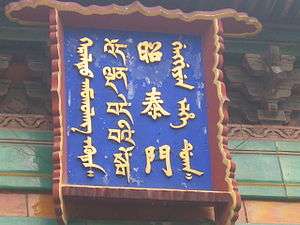 A sign of Symbol Thriving Gate (昭泰門)
A sign of Symbol Thriving Gate (昭泰門)- Statue of Tsongkhapa
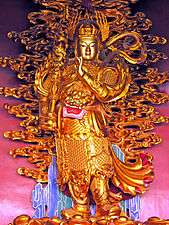 Statue of Wei Tuo
Statue of Wei Tuo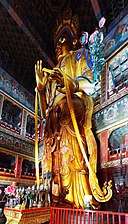 Statue of the Maitreya Buddha
Statue of the Maitreya Buddha Statue of the Maitreya Buddha
Statue of the Maitreya Buddha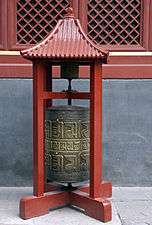
 A wall decoration
A wall decoration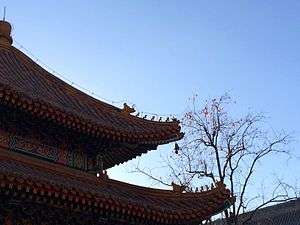 Roof at Yonghe Temple
Roof at Yonghe Temple
Further reading
- Lessing, Ferdinand, and Gösta Montell. Yung-Ho-Kung, an Iconography of the Lamaist Cathedral in Peking: With Notes on Lamaist Mythology and Cult. Stockholm: 1942.
References
- Reuters (4 March 1929). "Peking Revolt. Regiment of Troops Mutiny". The Singapore Free Press and Mercantile Advertiser. Retrieved 26 October 2018.
- Zatko, M. (2014). The Rough Guide To Beijing. (fifth edition). Rough Guides. London, UK
- Zatko, M. (2014). The Rough Guide To Beijing. (fifth edition). Rough Guides Ltd. London, UK
- Zatko, M. (2014). The Rough Guide To Beijing. (fifth edition). Rough Guides Ltd. London, UK
- Lonely Planet Beijing 10th Edition (Oakland, CA: Lonely Planet Publications, 2007), 134.
External links
| Wikimedia Commons has media related to Yonghe Temple. |
- Official Yonghe Temple website—(in Chinese)
- Beijingtrip.com: Yonghe Lama Temple
- GoogleMaps: Satellite photo of the Yonghe Temple — centered on the Hall of Everlasting Protection.
- Tibet.cn: "Beijing Lama Temple donates Buddha statue to Mongolia" —(in English)